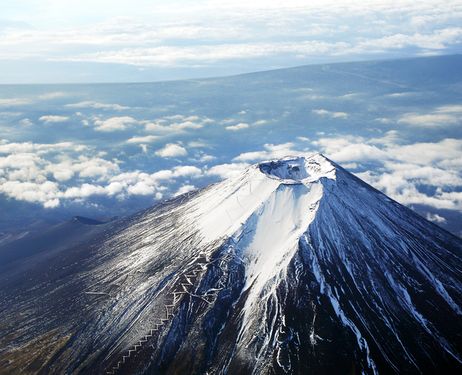 Japan - Japan should brace for a catastrophic volcanic eruption at some point, say experts, citing a massive buildup of magma at many of the nation's 110 active volcanoes.
Japan - Japan should brace for a catastrophic volcanic eruption at some point, say experts, citing a massive buildup of magma at many of the nation's 110 active volcanoes.
The last particularly serious eruption in Japan occurred in 1914, when Mount Sakurajima in southern Kagoshima Prefecture blew its top.
According to study by volcanologists, Japan, which lies on the Pacific Rim of Fire, has been shaken by more than 1,000 volcanic eruptions over the past 2,000 years.
"The possibility of a major eruption in the future is real," said Yoichi Nakamura, a professor of volcanology at Utsunomiya University who has been analyzing volcanic eruptions with a team of researchers.
To be classified as active, a volcano must have erupted within the past 10,000 years or still be spewing gases, according to the Japan Meteorological Agency.
The active volcanoes include sites in the disputed Northern Territories off northeastern Hokkaido as well as undersea volcanoes.
Of the 110 active volcanoes, the agency monitors activity of the 47 around the clock to detect signs of an imminent eruption.
When offshore Mount Sakurajima erupted, it spewed out so much lava that it created a land bridge with the Osumi Peninsula. Volcanic ash even fell on eastern Japan.
The researchers said seismic activity surged at 20 active volcanoes around Japan, including Mount Fuji, after the magnitude-9.0 Great East Japan Earthquake struck last year.
It was one of the most powerful earthquakes on record. It struck with such force that the Japanese land mass shifted.
Over the past century, volcanic eruptions around the world were apparently triggered by magnitude-9.0 or stronger earthquakes that struck several years earlier.
Nakamura also is involved with the nonprofit Vocanological Society of Japan. He said the study was intended to help local officials prepare for a contingency resulting from a major eruption by assessing the risks posed by volcanoes around the country.
Particularly worrisome, he said, was a lack of data pointing to a reduction in magma. In the absence of a really huge eruption for a century suggested there was a massive buildup of magma, which at some point will inevitably spew from a volcano with tremendous force.
According to the study, 1,162 eruptions have occurred in Japan over the past 2,000 years. Of these, 52 were major events that spewed a massive volume of ash and lava over a short period. It amounts to a large-scale eruption occurring every 38 years.
Records show that three volcanic eruptions in the 17th century, including one at Mount Hokkaido-Komagadake in Hokkaido in 1640, spewed out the equivalent of 1 billion cubic meters of ash and lava.
Two similar eruptions occurred in the 18th century, one of which involved Mount Fuji in 1707. The study showed that relatively large eruptions occurred 124 times.
There were 562 instances of medium-scale eruptions, or one every 3.6 years.
These included the eruption of Mount Unzen-Fugendake in Nagasaki Prefecture in 1991 and the eruption of Mount Usuzan in Hokkaido in 2000.
Of the 1,162 eruptions, the 47 volcanoes consistently monitored by the Japan Meteorological Agency represent nearly 90 percent of the activity, or 1,012 of those events.
Mount Aso in Kumamoto Prefecture is the most active volcano with 167 recorded eruptions, followed by Mount Asama straddling Nagano and Gunma prefectures, at 124; Mount Sakurajima, at 91; Mount Izu-Oshima in Tokyo, at 77; and Mount Kirishima straddling Kagoshima and Miyazaki prefectures, at 70. Mount Fuji has erupted 38 times.
source: http://ajw.asahi.com
